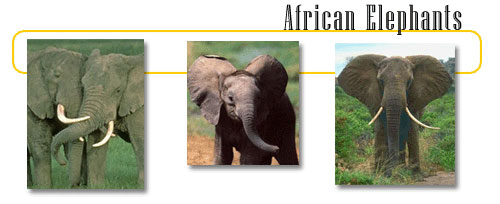
Loxodonta is a genus in Elephantidae, the family of elephants and is divided into two species.
The African Bush Elephant (Loxodonta africana) is the better-known and larger of the two species of African elephants. Both it and the African Forest Elephant were previously classified as a single species, known simply as the African Elephant. It is also known as the Bush Elephant or Savanna Elephant.
Sizes and Scales: The African Bush Elephant is the largest land dwelling animal, normally reaches 6 to 7.3 m (20 to 24 ft) in length and 3 to 3.5 meters in height, although a 4-meter elephant, the body of which is mounted in the rotunda of the National Museum of Natural History in Washington, D.C., was discovered in Angola in 1955.
Big and Brisk: Weighing between 7,000 and 10,000 kg (15,000-22,000 lb), it is the largest land animal in the world. It moves at a rate of 6 km/h, but it can reach a top speed of 40 km/h when scared or upset.
Big-headed: The animal is characterized by its large head; two large ears that cover its shoulders and radiate excess heat; a large and muscular trunk; two prominent tusks, which are well-developed in both sexes, although more commonly in males; a short neck; a large, barrel-like body; four long and heavy legs that resemble columns; and a relatively short tail.
 Thick Skinned:
Thick Skinned: The animal is protected by a heavy but flexible layer of gray-brown skin, dotted with mostly undeveloped patches of hair and long, black hair at the tip of its tail. Its back feet have three toes that form a hoof, while the number of toes on the front feet have varied between four and five, in different instances. The front is smoother and less convex than that of the Asian Elephant.
Nose + Lip = Trunk: The trunk is the most characteristic feature of the African Bush Elephant. It is formed by the fusion and elongation of the nose and upper lip, forming a flexible and strong organ made purely of muscle.
Intellectual Giants? A recent report states that African elephants are able to use seismic vibrations at infrasound frequencies for communication. The African Bush Elephant is a notably intelligent animal. In fact, experiments about reasoning and learning applied on them show that they are the smartest ungulates together with their Asian cousins. This is mostly due to their large brain.
African & Asian: Differences between the African Bush Elephant and the African Forest Elephant include the Forest Elephant's long, narrow mandible (the African Bush Elephant's is short and wide), its rounded ears (an African Bush Elephant's ears are more pointed), different tusks, and considerably smaller size. The Male African Forest Elephant rarely exceed 2.5 meters (8 feet) in height, while the African Bush Elephant is usually over 3 meters (just under 10 feet) and sometimes almost 4 meters (13 feet) tall.

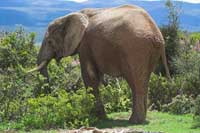 What's on the menu?
What's on the menu? African elephants are herbivorous. The diet of the African Bush Elephant varies according to its habitat; elephants living in forests, partial deserts, and grasslands all eat different proportions of herbs and tree or shrubbery leaves.
Chew on this! In order to break down the plants they consume, the African Bush Elephant has four large molars, two in each mandible of the jaw. Each of these molars is 10 cm wide and 30 cm long. Over time, these molars are worn away and new ones are grown to replace them as the elephant ages. Around the age of 15 their milk teeth are replaced by new ones that last until the age of 30, and then by another set which wear off past the age of 40, being replaced by the last set of teeth that last approximately until the age of 65–70. Not much later, the animal dies of starvation from not being able to feed correctly. There are known cases of over 80 year old specimens in captivity.
Big Appetite: These animals typically ingest an average of 225 kg of vegetable matter daily, which is defecated without being fully digested. That, combined with the long distances that they can cover daily in search of more food, contributes notably to the dispersion of many plant seeds that germinate in the middle of a nutrient-filled feces mound. In their feeding-oriented whereabouts, elephants rip apart all kind of plants, and knock down trees with the tusks if they are not able to reach the tree leaves not even standing up straight, as actual living bulldozers. It can be said that they carry devastation with them. That causes deep trouble for other species and to the elephants themselves in national parks where there is overpopulation, so that managers of overpopulated parks often contact other parks with fewer specimens to transfer excess individuals.
 Thirst Quencher:
Thirst Quencher: Elephants also drink great quantities of water, over 190 liters per day.
Mothers Rule: Herds are made up of related females and their younglings of assorted ages, directed by the eldest female, called the
matriarch. Infrequently, an adult male goes with them, but those usually leave the pack when reaching adolescence to form herds with other elephants of the same age. Later, they spread out, carrying out a lonely life, approaching the female herds only during the mating season. Nevertheless, elephants don't get too far from their families and recognize them when re-encountered. Sometimes, several female herds can blend for a period of time, reaching even hundreds of individuals.
 Herd Is Where The Heart Is:
Herd Is Where The Heart Is:
The matriarch is the one who decides the route and shows to each other member of the herd all the water sources she knows, which the rest will memorize in the future.
The relations among the members of the herd is very tight; when a female gives birth to a baby the rest go to acknowledge it by touching her with the trunk; and when an old elephant dies the rest of the herd will stay by the corpse for a while.
The famous elephant graveyards are a myth, but it is true that these animals can recognize a carcass of its species when they find one during their trips, and even if it is a stranger, they form around it and sometimes they even touch its forehead with their trunk.
Killing Rhinos: Some African Bush Elephants will attack and kill rhinoceroses. This behavior, when it occurs, is mostly observed with younger adult male elephants who have come into musth prematurely.
Natural Predators: The adult African Bush Elephant lacks natural predators thanks to its great size, but the calves (especially the newborn) are vulnerable to lion, leopard, crocodile, and, more rarely, hyena attacks. Adult females of a group will attack approaching predators. Predation, as well as drought, contribute significantly to infant mortality.
 Human Predators:
Human Predators: Humans are the elephant's major predator. Elephants have been hunted for meat as well as the rest of the body, including skin, bones, and tusks. Elephant trophy-hunting increased in the 19th and 20th centuries, when tourism and plantations increasingly attracted sport hunters.
In 1989, hunting of the African elephant and ivory trading were forbidden, after the elephant population fell from several million at the beginning of the 20th century to fewer than 700,000. The population of African elephants was halved during the 1980s. Scientists then estimated that, if no protective measures were taken, the wild elephant would be extinct by 1995. The protection that the elephant now receives has been partially successful, but despite increasingly severe penalties imposed by governments against illegal hunting, poaching is still common. CITES still considers this species as threatened with extinction.

 Birds and Bees:
Birds and Bees: Mating for a
African Bush Elephant happens when the female feels ready, an event that can occur anytime during the year. When she is ready, she starts emitting infrasounds that attract the males, sometimes many kilometers away.
The adult males start arriving to the herd during the following days and begin fighting head-to-head between them, causing some injuries and even broken tusks. The female shows her acceptance of the victor by rubbing her body against his. They mate, and then both go their own way.
Incredibly Long Pregnancy: After 22 months of gestation (the longest among mammals), the female gives birth to a single 90cm-high calf which weighs more than 100 kg.
The baby feeds on the mothers milk until the age of 5, but also eats solid food from as early as 6 months old. Just a few days after birth the calf can follow the herd by foot, and so the herd resumes its course.

 Classification Confusion:
Classification Confusion: Until recently, it was thought that the so-called
African Forest Elephant (
Loxodonta cyclotis) was simply a subspecies of the African Bush Elephant (
Loxodonta africana).
DNA testing has now shown that there are in fact three extant elephant species: the two African types (formerly considered to be separate populations of a single species, the African Elephant) and the South Asian species, known as the Indian or Asian Elephant. The North African elephant of Hannibal fame was a now-extinct fourth species or a subspecies of the Forest Elephant (
Loxodonta (africana) pharaoensis); it disappeared around the 1st or 2nd century CE.
The disputed Pygmy Elephants of the Congo basin, often assumed to be a separate species (
Loxodonta pumilio) by cryptozoologists, are probably Forest Elephants whose diminutive size and/or early maturity is due to environmental conditions.
Late in the 20th century, conservation workers established a DNA identification system to trace the origin of poached ivory. It had long been known that the ivory of the African Forest Elephant was particularly hard, with a pinkish tinge, and straight (whereas that of the African Bush Elephant is curved). The DNA tests, however, indicated that the two populations were much more different than originally thought—indeed, in its genetic makeup, the African Forest Elephant is almost two-thirds as distinct from the African Bush Elephant as the Asian Elephant is.
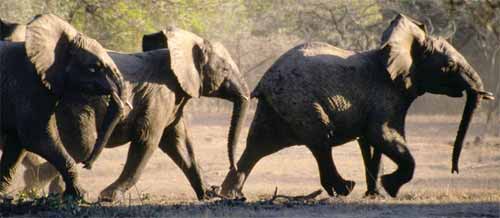
 Echolocation in bats is generally seen as a sort of natural sonar, in which the bats use ultrasonic clicks to navigate the night sky and find prey. But it may also be a rudimentary language, transmitting greetings and social information.
Echolocation in bats is generally seen as a sort of natural sonar, in which the bats use ultrasonic clicks to navigate the night sky and find prey. But it may also be a rudimentary language, transmitting greetings and social information.









 The Plains zebra (Equus quagga, formerly Equus burchelli) is the most common, and has or had about five subspecies distributed across much of southern and eastern Africa. It, or particular subspecies of it, have also been known as the Common zebra, the Dauw, Burchell's zebra (actually the subspecies Equus quagga burchelli), and the Quagga (another, extinct, subspecies, Equus quagga quagga).
The Plains zebra (Equus quagga, formerly Equus burchelli) is the most common, and has or had about five subspecies distributed across much of southern and eastern Africa. It, or particular subspecies of it, have also been known as the Common zebra, the Dauw, Burchell's zebra (actually the subspecies Equus quagga burchelli), and the Quagga (another, extinct, subspecies, Equus quagga quagga).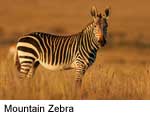 The Mountain Zebra (Equus zebra) of southwest Africa tends to have a sleek coat with a white belly and narrower stripes than the Plains zebra. It has two subspecies and is classified as endangered.
The Mountain Zebra (Equus zebra) of southwest Africa tends to have a sleek coat with a white belly and narrower stripes than the Plains zebra. It has two subspecies and is classified as endangered. arid grasslands of Ethiopia, Somalia, and northern Kenya. The Grevy's zebra is one of the rarest species of zebra around today, and is classified as endangered.
arid grasslands of Ethiopia, Somalia, and northern Kenya. The Grevy's zebra is one of the rarest species of zebra around today, and is classified as endangered. wildebeests. Unlike many of the large ungulates of Africa, Plains zebras prefer but do not require short grass to graze on. In consequence, they range more widely than many other species, even into woodlands, and they are often the first grazing species to appear in a well-vegetated area.
wildebeests. Unlike many of the large ungulates of Africa, Plains zebras prefer but do not require short grass to graze on. In consequence, they range more widely than many other species, even into woodlands, and they are often the first grazing species to appear in a well-vegetated area.  The Donkey Connection: Grevy's zebra is similar to the asses in many ways. Behaviorally, for example, it has a social system characterized by small groups of adults associated for short time periods of a few months. Adult males spend their time mostly alone in territories of 2-12 km², which is considerably smaller than the territories of the wild asses.
The Donkey Connection: Grevy's zebra is similar to the asses in many ways. Behaviorally, for example, it has a social system characterized by small groups of adults associated for short time periods of a few months. Adult males spend their time mostly alone in territories of 2-12 km², which is considerably smaller than the territories of the wild asses. 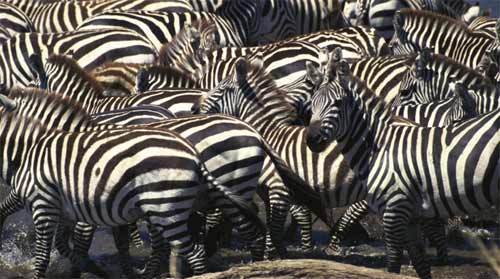



 What's on the menu? African elephants are herbivorous. The diet of the African Bush Elephant varies according to its habitat; elephants living in forests, partial deserts, and grasslands all eat different proportions of herbs and tree or shrubbery leaves.
What's on the menu? African elephants are herbivorous. The diet of the African Bush Elephant varies according to its habitat; elephants living in forests, partial deserts, and grasslands all eat different proportions of herbs and tree or shrubbery leaves.  Thirst Quencher: Elephants also drink great quantities of water, over 190 liters per day.
Thirst Quencher: Elephants also drink great quantities of water, over 190 liters per day.
 Human Predators: Humans are the elephant's major predator. Elephants have been hunted for meat as well as the rest of the body, including skin, bones, and tusks. Elephant trophy-hunting increased in the 19th and 20th centuries, when tourism and plantations increasingly attracted sport hunters.
Human Predators: Humans are the elephant's major predator. Elephants have been hunted for meat as well as the rest of the body, including skin, bones, and tusks. Elephant trophy-hunting increased in the 19th and 20th centuries, when tourism and plantations increasingly attracted sport hunters.  Birds and Bees: Mating for a African Bush Elephant happens when the female feels ready, an event that can occur anytime during the year. When she is ready, she starts emitting infrasounds that attract the males, sometimes many kilometers away.
Birds and Bees: Mating for a African Bush Elephant happens when the female feels ready, an event that can occur anytime during the year. When she is ready, she starts emitting infrasounds that attract the males, sometimes many kilometers away.  Classification Confusion: Until recently, it was thought that the so-called African Forest Elephant (Loxodonta cyclotis) was simply a subspecies of the African Bush Elephant (Loxodonta africana).
Classification Confusion: Until recently, it was thought that the so-called African Forest Elephant (Loxodonta cyclotis) was simply a subspecies of the African Bush Elephant (Loxodonta africana). 
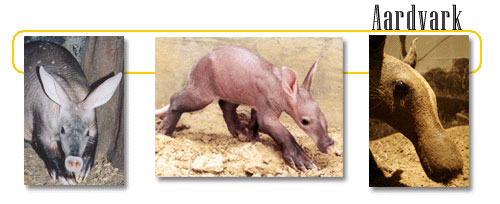
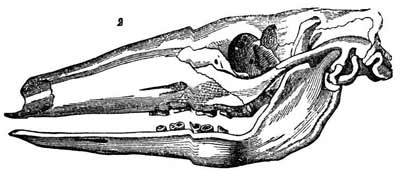
 termites is found, the Aardvark digs into it with its powerful front legs, keeping its long ears upright to listen for predators, and takes up an astonishing number of insects with its long, sticky tongue—as many as 50,000 in one night has been recorded. It is an exceptionally fast digger, but otherwise moves rather slowly.
termites is found, the Aardvark digs into it with its powerful front legs, keeping its long ears upright to listen for predators, and takes up an astonishing number of insects with its long, sticky tongue—as many as 50,000 in one night has been recorded. It is an exceptionally fast digger, but otherwise moves rather slowly.








